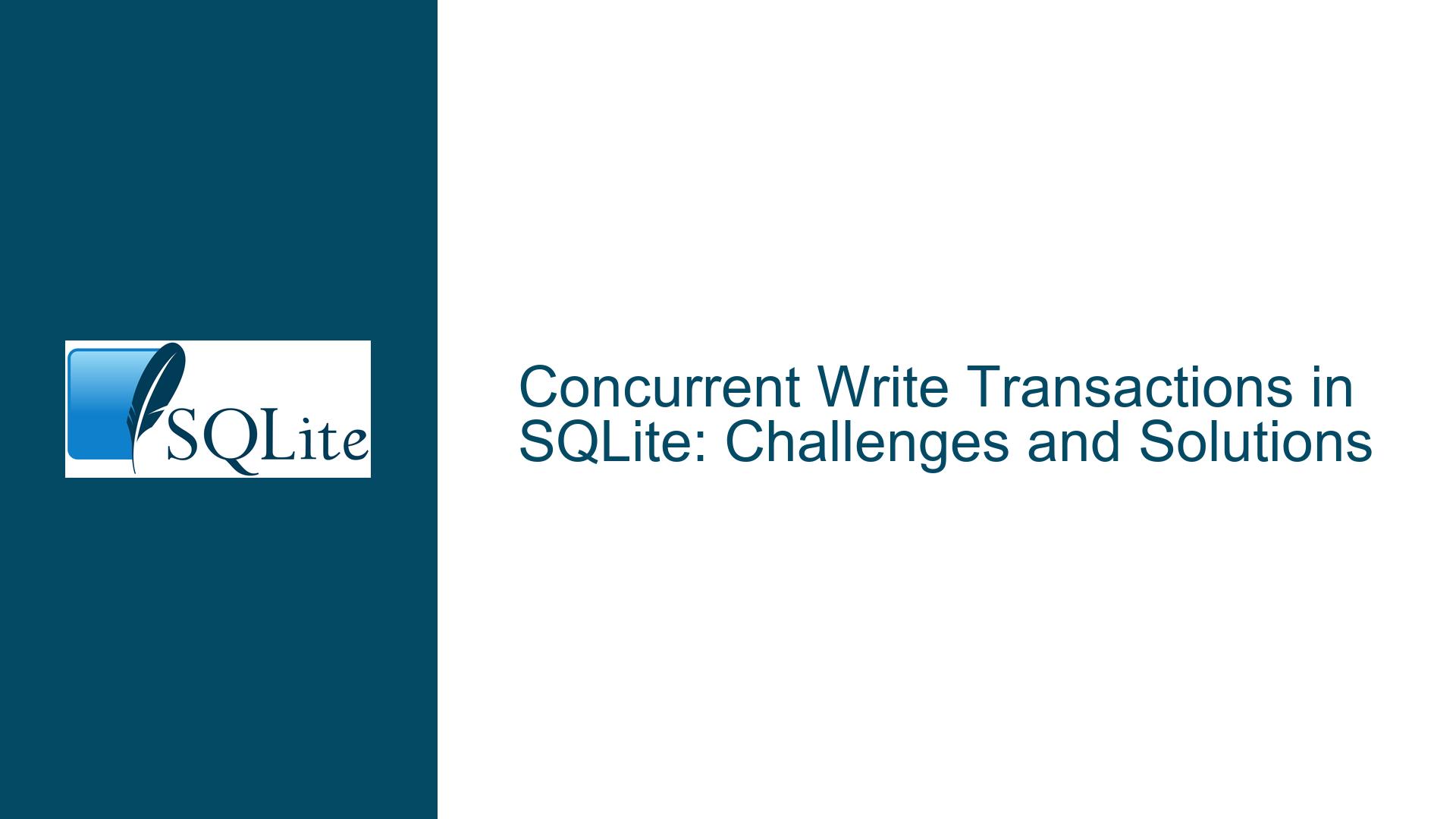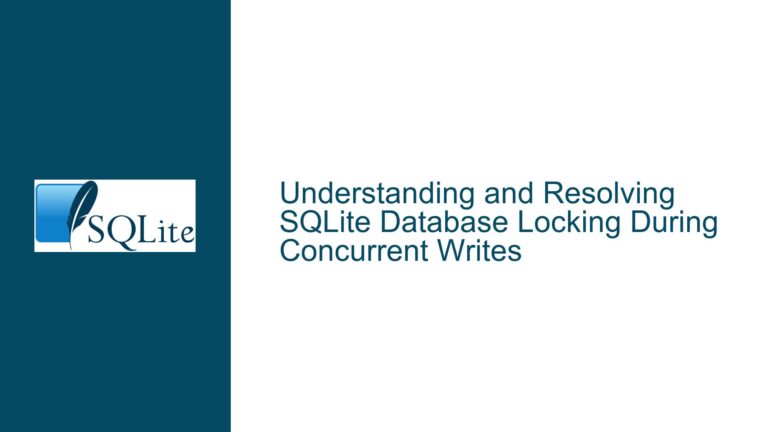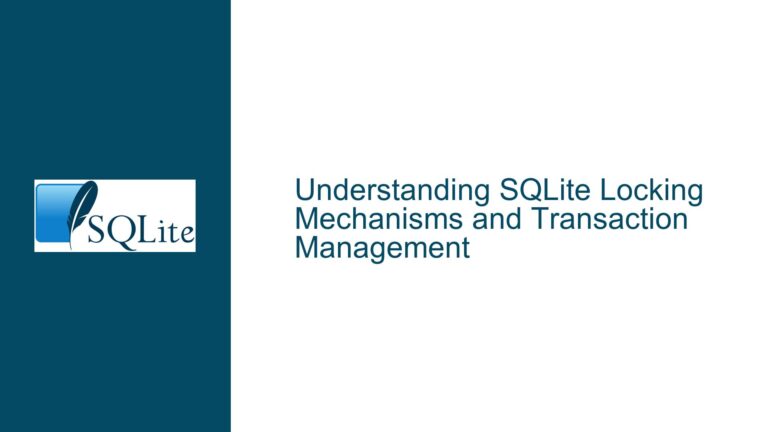Concurrent Write Transactions in SQLite: Challenges and Solutions
SQLite’s "BEGIN CONCURRENT" Feature for Concurrent Write Transactions
SQLite is renowned for its lightweight, serverless architecture, making it a popular choice for embedded systems, mobile applications, and small-scale web applications. However, one of its historical limitations has been its handling of concurrent write transactions. Traditionally, SQLite employs a write-ahead logging (WAL) mode to allow multiple readers or a single writer to access the database simultaneously. This means that while multiple read operations can occur concurrently, write operations are serialized, leading to potential bottlenecks in high-concurrency scenarios.
The "BEGIN CONCURRENT" feature is an experimental enhancement aimed at addressing this limitation by allowing multiple write transactions to occur concurrently. This feature is particularly useful in scenarios where multiple services or processes need to perform write operations on the same database simultaneously. However, as of the current state, this feature is not yet part of the main SQLite branch and is available only in a separate development branch. This has led to confusion and challenges for developers, especially those using programming languages like C#, who are eager to leverage this capability but find limited documentation and examples.
The core issue revolves around the implementation and usage of "BEGIN CONCURRENT" in real-world applications. Developers need to understand not only how to enable and use this feature but also the underlying mechanisms that make it work, the potential pitfalls, and the best practices for ensuring data integrity and performance.
Challenges with Concurrent Write Transactions in SQLite
The primary challenge with implementing concurrent write transactions in SQLite lies in its architecture. SQLite was designed with simplicity and minimal resource usage in mind, which inherently limits its ability to handle high levels of concurrency. The traditional WAL mode improves concurrency by allowing readers to operate without blocking writers and vice versa, but it still enforces a single-writer rule. This means that if two or more processes attempt to write to the database simultaneously, one will be blocked until the other completes its transaction.
The "BEGIN CONCURRENT" feature aims to mitigate this by introducing a mechanism that allows multiple writers to operate concurrently. However, this introduces several complexities. First, the feature is still experimental and not yet part of the stable SQLite release. This means that it may not be as thoroughly tested or as widely supported as other features. Second, the implementation details are not well-documented, making it difficult for developers to understand how to use it effectively. Third, even with "BEGIN CONCURRENT," there are still limitations and potential issues that need to be addressed, such as the risk of deadlocks or data corruption if not used correctly.
Another challenge is the integration of this feature with different programming languages and frameworks. For instance, C# developers may find it difficult to locate the necessary libraries or APIs to enable "BEGIN CONCURRENT" transactions. Additionally, the lack of examples and best practices further complicates the adoption of this feature. Developers must navigate these challenges while ensuring that their applications remain performant and reliable.
Implementing and Troubleshooting "BEGIN CONCURRENT" in SQLite
To effectively implement and troubleshoot "BEGIN CONCURRENT" transactions in SQLite, developers must first understand the prerequisites and setup requirements. The feature is currently available in a separate branch of SQLite, which means that developers need to compile SQLite from source or use a precompiled binary that includes this feature. Once the necessary version of SQLite is installed, the next step is to enable the feature in the application.
In C#, this typically involves using a library like System.Data.SQLite or Microsoft.Data.Sqlite to interact with the SQLite database. However, these libraries may not yet have built-in support for "BEGIN CONCURRENT," requiring developers to manually execute the necessary SQL commands to enable and use the feature. For example, to start a concurrent write transaction, developers would need to execute the "BEGIN CONCURRENT" SQL statement before performing any write operations.
One of the key considerations when using "BEGIN CONCURRENT" is the handling of conflicts and errors. Since multiple writers are operating concurrently, there is an increased risk of conflicts, such as attempts to modify the same data simultaneously. SQLite provides mechanisms to handle these conflicts, such as the "ON CONFLICT" clause, which allows developers to specify how to resolve conflicts when they occur. However, developers must carefully design their transactions and error-handling logic to ensure that conflicts are resolved gracefully and that data integrity is maintained.
Another important aspect is the configuration of the SQLite database to support concurrent write transactions. This includes setting the appropriate journal mode, which determines how SQLite handles transaction logging and recovery. The WAL mode is generally recommended for concurrent transactions, as it allows readers and writers to operate simultaneously without blocking each other. However, developers should also consider other settings, such as the synchronous mode, which controls how SQLite writes data to disk. A lower synchronous mode can improve performance but increases the risk of data corruption in the event of a crash.
To troubleshoot issues with "BEGIN CONCURRENT" transactions, developers should start by examining the SQLite error logs and any error messages returned by the database. These logs can provide valuable insights into the cause of conflicts or errors, such as deadlocks or constraint violations. Additionally, developers can use tools like the SQLite command-line interface (CLI) to manually execute transactions and observe their behavior. This can help identify any issues with the transaction logic or database configuration.
In cases where conflicts or errors persist, developers may need to revisit their transaction design and consider alternative approaches. For example, breaking down large transactions into smaller, more manageable ones can reduce the likelihood of conflicts. Additionally, using techniques like optimistic concurrency control, where transactions are validated before committing, can help prevent conflicts from occurring in the first place.
Finally, developers should stay informed about the latest developments and updates related to the "BEGIN CONCURRENT" feature. As this feature is still experimental, it is likely to evolve over time, with improvements and bug fixes being introduced in future releases. By keeping up-to-date with the latest changes, developers can ensure that they are using the feature in the most effective and reliable way possible.
In conclusion, while the "BEGIN CONCURRENT" feature in SQLite offers the potential for improved concurrency and performance, it also introduces several challenges and complexities. Developers must carefully navigate these challenges by understanding the feature’s implementation, configuring the database appropriately, and designing robust transaction logic. By following best practices and staying informed about the latest developments, developers can successfully leverage "BEGIN CONCURRENT" to build high-performance, concurrent applications with SQLite.






